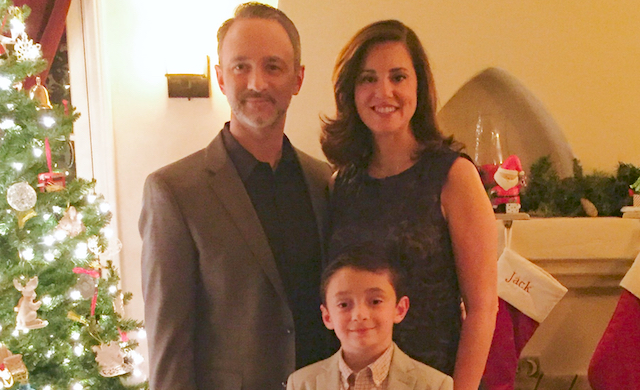
Persistence or Acceptance? Both are Necessary When Facing Secondary Infertility
04/24/2017 06:00AM | 8375 viewsBy Patricia Musitano
It seems like there’s always a reason to keep trying. There’s
something that makes you think the next time will work. Something that was
wrong gets fixed … a new procedure offers hope … an eventual success makes you
think it will be possible to do it again.
After my husband and I had been trying to get pregnant for a year, my OB/GYN referred me to a fertility specialist who happened to be a parishioner at my church! I saw that as a sign and, believe me, I was looking for signs. We went through all sorts of testing, and then tried a few rounds of artificial insemination without success. The next step was in vitro fertilization (IVF).
My first IVF was a shock. I was an emotional wreck. The effects of the hormones were totally unexpected. I warn all who tread into the world of fertility treatments to expect a severe reaction. Perhaps you will fare better than I did, but at least you will be prepared. I remember standing in a Nordstrom with my husband arguing to the point of tears about a pair of shoes. I had never been so irritable! Of course, I had also never produced 16 eggs in one month before, either!
I got pregnant that first time, but after eight weeks there was no heartbeat. That was very difficult. Still, we were encouraged by the experience of having gotten pregnant on the first round of IVF—finally achieving that goal—after so many previous tries.
I’m a very persistent person, as is my husband. The never-give-up types. So we tried again, buoyed by our first minor success. And again. Sometimes we would fail and sometimes we would get pregnant, but there wouldn’t be a heartbeat. Six times through the hormonal roller coaster. It was awful. It was especially awful for my family. I eventually learned to give myself much-needed “time outs.”
Then my 7th IVF worked. We still remember the day we heard the heartbeat—it was the greatest sound we’d ever heard. Six years after we’d started treatments, my son Jack was born healthy and perfect and wonderful.
After taking some time to just enjoy Jack, we decided to try again. We were back on the roller coaster, again buoyed by the success of achieving a live birth, the goal of every potential parent. We went through many more IVFs and procedures, some pregnancies, all of which ultimately ended.
The most difficult one was lost at the end of the first trimester. All had been well up until then. We’d reached that graduation point when you shift from the fertility doctor to the OB/GYN—that’s a big step. I even had to start wearing maternity clothes. We told our friends the great news. Then, that very night, we lost the baby. Again.
After that miscarriage, the doctor did some tests and discovered a new problem, probably a result of a prior procedure, so he cleaned that up. Yet again, more potential, more hope: here’s something that was wrong that was fixed. Next time it’s going to work. So we tried again and again. It didn’t work.
Secondary Infertility
What we were experiencing after my son’s birth is referred to as secondary infertility: the inability to become pregnant, or to carry a pregnancy to term, following the birth of a biological child.
Obviously our desire to become parents had been fulfilled, so I don’t pretend the emotional impact is the same as the first time around. But we were also buoyed by this idea that we’ve succeeded in the past. It worked once. It should work again, right?
For me, that success created a foundation for persistence.
Anyone who knows this process knows the hormones wreak havoc. So I was excited to learn about an approach that was new at the time, called minimal stimulation IVF. Instead of getting the shots of hormones to stimulate the follicles to make eggs, the patient is given Clomid to cause the body to create more eggs than normal. The eggs are retrieved, fertilized and preserved, then put back into the womb on the next cycle. The process take a little longer and you are likely to produce fewer eggs than with the hormone shots, but the body doesn’t have to go through the abuse of the large amounts of hormones.
I suggested this new process to my doctor but he didn’t go for it at first. Then a year later he finally agreed that I was a candidate. We tried a few times without success. Frankly, I stopped counting how many rounds of IVF we had been through during secondary infertility.
Ultimately, we decided to let it go. The decision of whether to continue trying is very personal. It depends on so many factors—spouse, family, finances, time, your energy level, mental state, and support system. Not everyone can try as many times as we did. I know it was a luxury in some sense and a torment in another sense.
Acceptance is not easy. But we have our son, who is beautiful inside and out. I’m so glad we were persistent enough to wait so long for him and accepting enough to enjoy him on his own.
Here are some things we learned along the way.
- Understand the science of the treatments as much as possible. Read about the procedures and ask a lot of questions so that you understand what’s happening to your body. This knowledge helps you combat your own negative thoughts. I used to think: “What if this isn’t meant to be?”No, if I had high cholesterol I wouldn’t say that. I’d try to fix it. If you understand how it all works, you feel better about it.
- The out-of-pocket costs were roughly the same whether the IVF was insured or not. Our insurance covered a certain number of fertility treatments, but there are still out-of-pocket costs. When the treatment wasn’t covered at all, the clinics often gave a discounted rate. All told, our costs were about $10,000 per IVF, insured or not.
- Compare the live birth stats for clinics in your area. The Centers for Disease Control and Prevention (CDC) collects data from fertility clinics and makes that data available to the public. It’s a spreadsheet, so it’s not easy to search, but the information is there. Check the number of live births. As I learned from my own experience, it doesn’t matter how many pregnancies they report, it matters how many babies they help make. Another tip: the embryologist is the most important person. Other doctors are important for bedside manner and seeing you through the process and making sure your body is ready. But the embryologist is the rock star.
- Talk about your experience with others. It was hard for me to tell people I wanted children, because I didn’t want people to feel bad for me. But in hindsight, I believe we should all be more open about our experiences. Yes, it’s a private matter. But it’s also a normal thing—it’s not something that needs to be hidden. When you’re going through it, even if you don’t think you want people to know—you may need people to know. Once you start talking about it, you will likely find that many women have experienced miscarriages and infertility, or have someone close to them that has.
In the end, what we needed most was to strike a balance between persistence and acceptance. I hope everyone can find a balance that works for them.











Post your Comment
Please login or sign up to comment
Comments